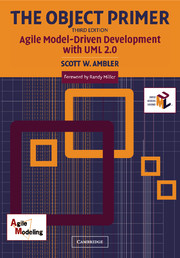Book contents
- Frontmatter
- Contents
- Acknowledgments
- Foreword
- Preface
- About the Author
- Chapter 1 Leading-Edge Software Development
- Chapter 2 Understanding the Basics–Object-Oriented Concepts
- Chapter 3 Full Lifecycle Object-Oriented Testing (FLOOT)
- Chapter 4 Agile Model–Driven Development (AMDD)
- Chapter 5 Usage Modeling
- Chapter 6 User-Interface Development
- Chapter 7 Supplementary Requirements
- Chapter 8 Conceptual Domain Modeling
- Chapter 9 Business Process Modeling
- Chapter 10 Agile Architecture
- Chapter 11 Dynamic Object Modeling
- Chapter 12 Structural Design Modeling
- Chapter 13 Object-Oriented Programming
- Chapter 14 Agile Database Development
- Chapter 15 Where to Go from Here
- Glossary
- References and Recommended Reading
- Index
Chapter 12 - Structural Design Modeling
Published online by Cambridge University Press: 03 March 2010
- Frontmatter
- Contents
- Acknowledgments
- Foreword
- Preface
- About the Author
- Chapter 1 Leading-Edge Software Development
- Chapter 2 Understanding the Basics–Object-Oriented Concepts
- Chapter 3 Full Lifecycle Object-Oriented Testing (FLOOT)
- Chapter 4 Agile Model–Driven Development (AMDD)
- Chapter 5 Usage Modeling
- Chapter 6 User-Interface Development
- Chapter 7 Supplementary Requirements
- Chapter 8 Conceptual Domain Modeling
- Chapter 9 Business Process Modeling
- Chapter 10 Agile Architecture
- Chapter 11 Dynamic Object Modeling
- Chapter 12 Structural Design Modeling
- Chapter 13 Object-Oriented Programming
- Chapter 14 Agile Database Development
- Chapter 15 Where to Go from Here
- Glossary
- References and Recommended Reading
- Index
Summary
Think before you code.
The purpose of structural design modeling is exactly what the name implies—to model the design of the structural aspects of your system. Structural design focuses on the identification of entities, classes or data structures, and the relationships among those entities. For modern systems there are two basic styles of structure that you need to be concerned about at the detailed design level. The first is the design of your object schema, something that is typically modeled with a class diagram. The second is the design of your database, something that is done with a physical data model (PDM).
This chapter addresses the following topics:
UML class diagrams;
Applying design patterns effectively; and
Physical data modeling with the UML.
UML CLASS DIAGRAMS
The purpose of design is to model how the software will be built; as you would expect, the purpose of design class modeling is to model the static structure of how your software will be built. The techniques of analysis class modeling that you learned in Chapter 8 still apply. The only difference is your focus is on the solution domain instead of on the problem domain. In fact your analysis class model often evolves into your design class model—you simply introduce changes to your class model based on implementation technologies. Although modeling purists may insist that you keep your analysis and design models separate, the reality is that you will often work through requirements to analysis to design in a matter of minutes, sometimes even seconds.
- Type
- Chapter
- Information
- The Object PrimerAgile Model-Driven Development with UML 2.0, pp. 351 - 392Publisher: Cambridge University PressPrint publication year: 2004

